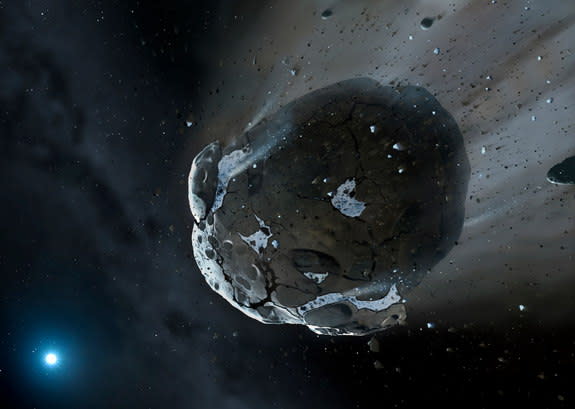 Science and Weather
Science and WeatherNewly-discovered asteroid could hit Earth in 2032

Astronomers discovered a new potentially hazardous asteroid this week, and they say it has a chance of hitting the Earth on August 26, 2032.
Asteroid 2013 TV135 was found on Saturday, October 12th, by astronomer Gennady Borisov, of the Crimean Astrophysical Observatory in the Ukraine, while he was scanning the northern constellation of Camelopardalis for comets. Tracking the movement of this 400-metre-wide asteroid over the days since and looking back through records to see if anyone had already spotted it, astronomers have been able to piece together its orbit around the sun. It turns out to be an Apollo asteroid, with a roughly 4-year orbit that takes it far out beyond the orbit of Mars and then back in to dip just inside the orbit of Earth.
It's 2013 TV135's dip inside Earth's orbit that's raised some eyebrows, and a few concerns. The asteroid's path makes it a 'Near-Earth Object', and since it comes within 7.5 million kilometres of Earth (around 20 times the distance to the Moon), it's immediately branded as a 'Potentially Hazardous Asteroid'. However, one particularly close pass (on astronomical scales, at least) — on August 26, 2032 — has also earned it a rating of 1 out of 10 on the Torino Impact Hazard Scale.
However, a Torino rating of 1 isn't anything special. There are plenty of new asteroids that get a ranking like that (or even a little higher) right when they're first discovered. It just means that it's new, there's 'no unusual level of danger' and further observations will likely reduce it to a rating of zero on the scale (which means that there's no chance of an impact).
As of October 17th, the chance of an actual impact is just 1 in 63,000, so it's already not very likely to hit us. However, with only 7 days of observations to work off of, the 'margin for error' in the calculations is probably quite large, and a close encounter on August 26, 2032 just happens to fall within the edges of that margin for error. The plot of the asteroid's orbit will get better with more observations, and that will tell us if it's truly something for us to worry about.
[ More Geekquinox: Researchers create deep-sea internet for faster tsunami warnings ]
The cause for concern with 2013 TV135 isn't so much it's path, but is size. If it was small, even if it was aimed at us with a 100% certainty of an impact, we could probably just ignore it, since it would burn up in the atmosphere. However, at 400 metres wide, if an asteroid as big and as fast-moving as this one were to hit Earth, it would be like setting off a 2,500 megaton nuclear bomb. For reference, the biggest nuclear bomb ever detonated, Tsar Bomba, was only 50 megatons.
Update, October 22nd: This is interesting... the probability of an impact actually increased since it was discovered. On October 18th, the odds changed from 1 in 63,000 to 1 in 48,000, and on October 19th it changed again, to 1 chance in 14,000. As of today, Tuesday, October 22nd, the odds went back down to 1 in 16,000, which shows that the final odds of impact are likely to settle somewhere around there.
Just to be clear, theses odds are a long way from any significant chance of an impact. In fact, a 1 in 16,000 chance of impact means that there's a 99.9937% chance that it won't hit Earth.
(Image courtesy: Reuters)
Geek out with the latest in science and weather.
Follow @ygeekquinox on Twitter!


